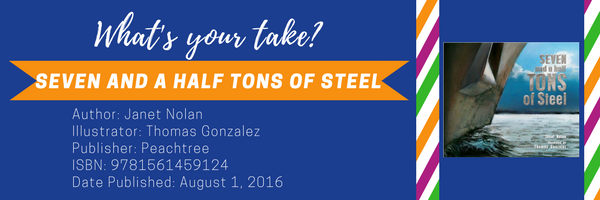This brief but powerful non-fiction text projects the journey of continuation onto a steel beam from the World Trade Center. The beam lives on, becoming an integral and enduring part of the warship USS New York in the aftermath of September 11. The Governor of New York donates the steel beam and it is driven to a Louisiana foundry where the USS New York is being constructed, and the beam becomes its bow. Ten years after 9/11, it makes its way back to New York on September 11, 2011.

DOREA: Similar to The Tree in the Courtyard, Seven and a Half Tons of Steel explores the theme of continuation as it may occur after a tragic, life-altering event. Rather than focusing on the site of tragedy, this story follows what is created from that tragedy. In this case, a single beam of steel from one of the fallen towers moves and reshapes into a US Navy vessel. Along the way, we meet the many people whose skills and talents make this transformation possible.
As the beam travels to Louisiana, the reader witnesses the ways that shipbuilders, engineers, electricians, mechanics, welders, carpenters, painters and plumbers all leave their mark on the steel. In My Grandfather’s Coat, the transformation of a piece of cloth is the work of one man, his actions known and visible to others. In Seven and a Half Tons of Steel, the author illuminates the multitude of actions behind the scenes that often go unnoticed or un-praised. This way, the reader considers transformation–or continuation–as a complex process that takes place over time.
Through the additional facts about the USS New York at the end of the book, the author and illustrator also show the ways in which a single image–the crest of the ship–can be filled with stories that preserve the memory of people, places and events. A detailed explanation of the crest shows that its symbols represent the Twin Towers, the state of New York, firefighters, police, lost lives and the integration of the beam into the ship. The crest reads “Never Forget.” While commemoration of tragic events is important, equally important are the stories that witness and celebrate the events that come after.
SEEMI: The visual narrative of this story brings to the forefront the strength, stability and durability of a warship. A bow is the forward part a ship, the point that is the most forward when the vessel is moving, which is symbolic in its implication of progress. The illustrator frames the journey of the beam from and to New York with the heart-wrenching images of the plane hitting The World Trade Center on 9/11 and the final scene where the ship triumphantly reenters the waters off of New York.
Another historical event that impacts the ship’s construction is when Hurricane Katrina devastates New Orleans and all work on the ship has to be stopped. It continues its journey when Camp Katrina is built and the workers, now with shelter, can work on the ship further. Even though the destruction of this event is only hinted at, the mention of the disaster adds to the resilience of the country, emphasizing the bounce-back after each trial from a natural or manmade disaster.
People of color are also a large part of the images within the text, which adds to the image of the USA as a melting pot of many diverse people. This event impacts all kinds of people within the USA and every patriotic individual applauds the construction of the ship and its symbolism.
Title: Seven and a Half Tons of Steel
Author: Janet Nolan
Illustrator: Thomas Gonzalez
Publisher: Peachtree
ISBN: 9781561459124
Date Published: August 1, 2016
This is the final installment of September 2017’s My Take/Your Take. To follow these continuing conversations, check back every Wednesday.
- Themes: Dorea Kleker, Janet Nolan, Seemi Aziz, Seven and a Half Tons of Steel, Thomas Gonzalez
- Descriptors: Books & Resources, My Take/Your Take
